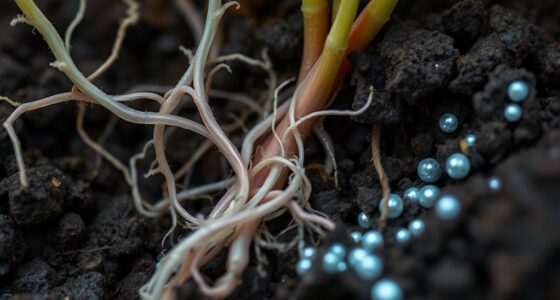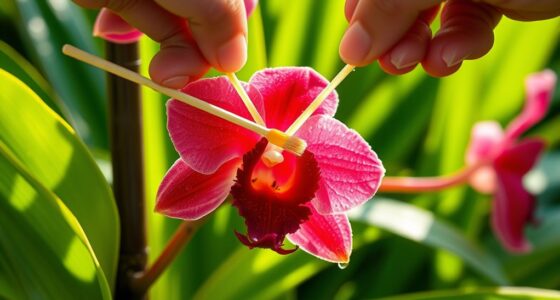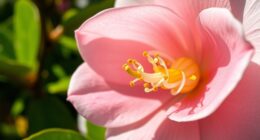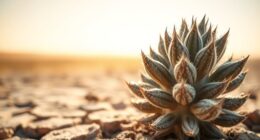Creating a rare plant terrarium is a fantastic way to house humidity-loving gems in glass enclosures. By choosing plants suited for high moisture, layering gravel and activated charcoal, and maintaining consistent misting, you can craft a self-sustaining mini-ecosystem. Proper care, pruning, and good airflow keep your setup healthy and vibrant. If you want to discover more tips on building the perfect environment for these delicate plants, continue exploring below.
Key Takeaways
- Select glass containers with ample space and proper drainage layers for humidity-loving plants.
- Incorporate moss, succulents, and rare plants suited for high moisture environments.
- Layer activated charcoal and soil to create a healthy, odor-free, and moisture-retentive ecosystem.
- Maintain high humidity through regular misting and monitor plants for signs of stress or mold.
- Design the terrarium to mimic natural habitats, ensuring sustainable, self-sufficient growth conditions.

Rare plant terrariums offer an enchanting way to bring unique greenery into your space. These glass enclosures create a miniature ecosystem that showcases some of the most unusual and mesmerizing plants. If you’re drawn to humidity-loving gems, you’ll find that these terrariums are perfect for housing such delicate species. The key to success lies in understanding how to craft the right environment within your glass container. You’ll want to focus on creating suitable conditions for moisture-loving plants, which thrive in high humidity and consistent moisture levels.
One way to enhance your rare plant terrarium is through succulent arrangements. While succulents are typically associated with dry conditions, you can select certain varieties that enjoy more humidity, or incorporate them into layered setups that balance moisture retention. Mixing succulents with moss cultivation can add texture, color, and visual interest. Moss acts as a natural humidity regulator, helping maintain the moist environment that many rare plants need. It’s also easy to cultivate inside a terrarium, provided you keep the humidity levels stable and avoid overwatering.
When designing your terrarium, start by choosing a glass container with enough space for your plants to grow. Layer the bottom with small stones or gravel to facilitate drainage, followed by activated charcoal to prevent odors and mold. On top of that, add a layer of soil suitable for the plants you intend to grow. If you’re cultivating moss, spread it across the soil surface, and gently press it down to secure it in place. For succulent arrangements, position the plants thoughtfully, ensuring they have enough room to flourish without overcrowding. Remember, the goal is to mimic their natural habitat, which often involves high humidity, but with proper aeration to prevent rot.
Maintaining the right moisture level is essential. Mist your terrarium regularly to keep humidity high, but avoid overwatering. Monitor the plants for signs of stress, such as wilting or mold, and adjust your watering schedule accordingly. Regularly pruning moss helps keep it healthy and vibrant, while removing any dead or decaying plant material prevents disease. If you notice condensation building up excessively, open the terrarium briefly to allow fresh air in and reduce excess moisture. Additionally, choosing sustainable gardening practices can help ensure your ecosystem remains healthy and environmentally friendly.
With patience and attention to detail, your rare plant terrarium can become a lush, self-sustaining environment. Incorporating succulent arrangements and cultivating moss will not only support the health of your humidity-loving plants but also create a stunning display that feels like a hidden jungle or a miniature rainforest in your home. As you tend to your glass enclosure, you’ll develop a deeper understanding of these delicate ecosystems, making your collection truly one of a kind.
Frequently Asked Questions
How Often Should I Water Humidity-Loving Plants in Terrariums?
You should water humidity-loving plants in terrariums based on their specific needs, but generally, check the soil weekly. Maintain consistent humidity levels by watering just enough to keep the soil moist, not soggy. Too much watering can cause mold or root rot, while too little can dry out the plants. Adjust your watering frequency according to the plant’s response, ensuring ideal humidity levels for healthy growth.
Can Rare Plants Thrive Outdoors in Humid Climates?
You might wonder if rare plants can thrive outdoors in humid climates. It depends on their specific climate suitability and outdoor humidity levels. If your local environment mimics their native habitat, with consistent humidity and appropriate sunlight, they could do well outside. However, if conditions are too variable or dry, you may need to provide extra care or consider indoor options like terrariums to maintain ideal humidity and protect your rare plants.
What Are Signs of Overwatering in Terrarium Plants?
Did you know that overwatering causes 80% of terrarium plant issues? Signs include soil moisture that’s too high and leaf discoloration, especially yellowing or browning. If your plants’ soil stays soggy or leaves look wilted despite adequate light, you’re likely overwatering. Adjust by letting the soil dry out slightly between waterings and make sure proper drainage. Monitoring these signs helps keep your plants healthy and thriving.
How Do I Prevent Mold and Pests in Glass Enclosures?
To prevent mold and pests in your glass enclosures, you should implement good ventilation strategies to promote airflow and reduce excess humidity. Keep the enclosure clean by removing dead leaves and debris regularly. Use pest prevention techniques like inspecting plants before introducing them and avoiding overwatering. Additionally, make certain proper drainage and avoid overcrowding, which can create damp, pest-friendly environments. These steps help maintain a healthy, mold-free, pest-resistant terrarium.
Are Artificial Lighting Options Necessary for Indoor Terrariums?
You might wonder if artificial lighting is necessary for your indoor terrarium. While natural light often suffices, artificial indoor grow lights can boost plant health, especially if your space lacks sufficient sunlight. Using grow lights isn’t always a necessity, but they’re a great option to guarantee your humidity-loving plants thrive. These grow lights provide consistent, controlled light, helping your plants grow strong and vibrant indoors.
Conclusion
Now that you know how to create and care for rare plant terrariums, why not bring these humidity-loving gems into your space? With a little attention and the right environment, you can enjoy a lush, miniature jungle indoors. Isn’t it rewarding to nurture such unique plants and watch them thrive in glass enclosures? Start your terrarium journey today and transform your home into a vibrant, green sanctuary filled with fascinating rare plants.










